#yumiko tabuchi
Text

Yumiko Tabuchi
214 notes
·
View notes
Text

田渕由美子ベストセレクション すてきなボーイフレンド編 (Tabuchi Yumiko Best Selection: Sutekina Boyfriend Hen), Yumiko Tabuchi
47 notes
·
View notes
Text
Shoujo Manga's Golden Decade (Part 2)
Shoujo manga, comics for girls, played a pivotal role in shaping Japanese girls’ culture, and its dynamic evolution mirrors the prevailing trends and aspirations of the era. For many, this genre peaked in the 1970s. But why?
Part 1
The Year of 24 Group
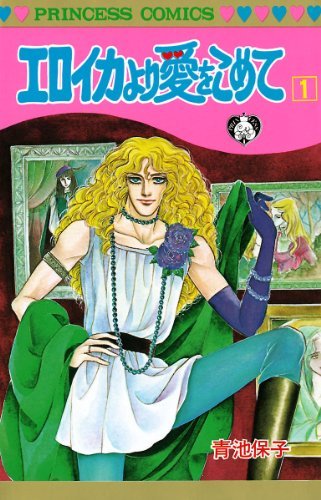
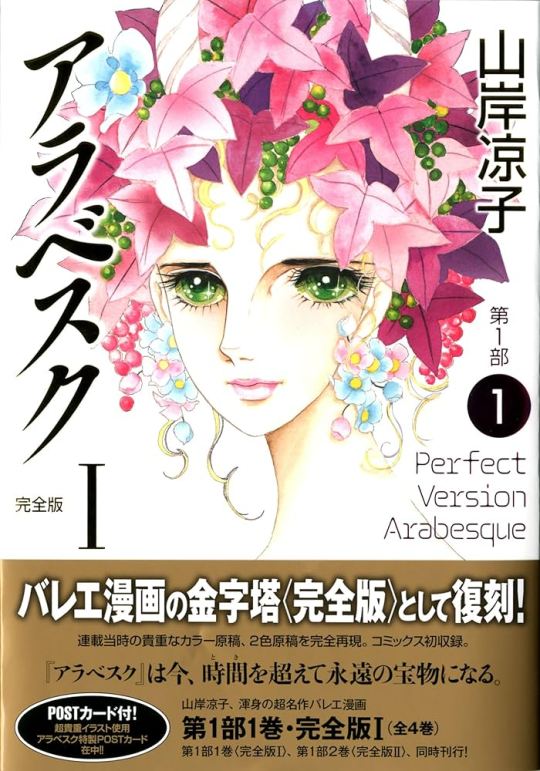
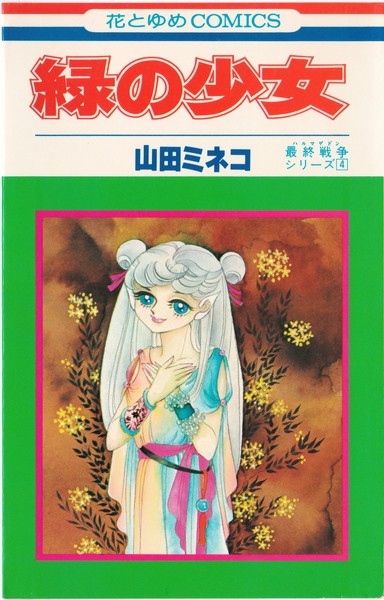

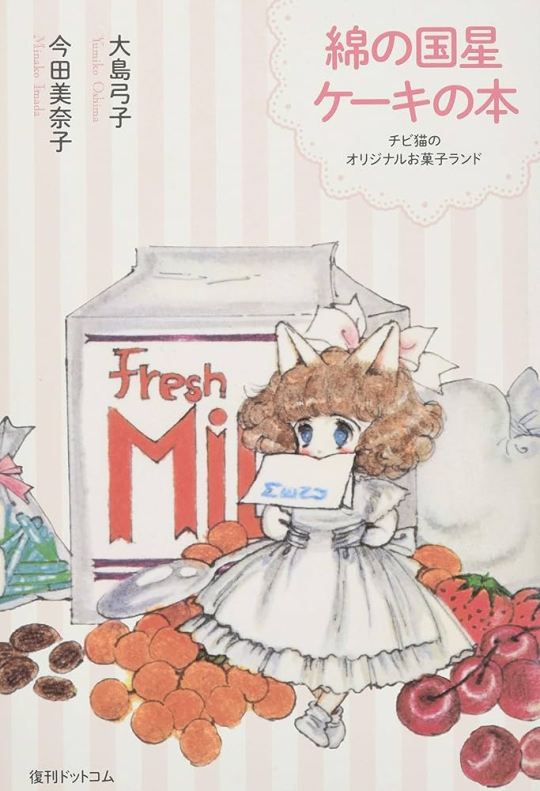

Some of the best-selling work by the Year 24 Artists (l-to-r): Yasuko Aoike's "From Eroica with Love," Ryoko Yamagishi's "Arabesque," Mineko Yamada's "Minori no Shoujo," Toshie Kihara's "Yomie no Ishibume," Yumiko Oshima's "The Star of Cottonland," Yuuko Kishi's "Tamasaburo."
Back in the early '70s, there was the prevailing notion that manga was for young kids. Despite the variety in themes, big magazines like Margaret, Shoujo Club, Nakayoshi, and Ribon were theoretically aimed at elementary school-aged girls.
In practice, the reality was more nuanced. Due to being published in Weekly Margaret, "The Rose of Versailles" was for kids. And it did very well with them. Yet, its revolutionary romance also appealed to broader audiences, exemplifying the crossover potential of shoujo manga. It was the title that opened the door for what is known as "the golden age of shoujo," which was further cemented by several other groundbreaking hits.
These hits widened the shoujo manga field, and soon, other editorial houses also wanted to cash in. Shogakukan, which published the powerful Weekly Shonen Sunday, entered the shoujo market in the late '60s. Shueisha and Shogakukan also partnered to form a keiretsu and open the Hakusensha publisher which deals mostly with shoujo manga.
That is the context in which a batch of artists known as "The Magnificent 24 Group" rose. And they were another key reason as to why '70s shoujo made such a mark. These manga-kas introduced themes such as sci-fi and homosexuality to the segment, revolutionized its art, further explored historical and terror narratives, and generally broke barriers of what was possible in shoujo manga. Their work was intellectually challenging, philosophical, and, above all, fundamental for male manga critics and connoisseurs to finally take shoujo seriously.
The Year 24 Group refers to the fact most artists were born around 1949, which is known as the year 24 of the Showa era in the Japanese calendar. These women came of age during the time artists like Hideko Mizuno were debuting and doing revolutionary work in the shoujo field, and they were eager to follow their lead. The success of unorthodox hits like "The Rose of Versailles" and the emergence of new magazines enabled them to be bold.
The two artists who led the movement are Moto Hagio and Keiko Takemiya. Their shared house in Tokyo, known as the Oizumi Salon, became a gathering place for several young artists keen on breaking new grounds for shoujo manga-kas. These women became the Year 24 group. But there were other two people, besides the artists themselves, who were just as crucial for the existence of the movement.
Firstly, there was Junya Yamamoto. Yamamoto was a young male editor at Shogakukan who had risen through the ranks of the successful Shonen Sunday weekly manga magazine. Noticing they were lagging behind Shueisha and Kodansha in the manga segment for their lack of a robust shoujo presence, the editorial house appointed Yamamoto to launch Shoujo Comic (known as Sho-Comi) in 1968 and Bessatsu Shoujo Comic (known as Betsucomi) in 1970. However, he quickly ran into an issue: most successful shoujo artists already had exclusive contracts with the competing houses, and aspiring names were vying for positions at the already established magazines.
In 1969, the "God of manga," Osamu Tezuka, introduced Yamamoto to Keiko Takemiya, then a university student living in Tokushima City. Takemiya had spent her school years dreaming of becoming a manga-ka and participated extensively in the readers' corner section of COM. COM was an avant-garde manga magazine Tezuka founded to nourish young talents and publish stories without the typical restraints of more commercial shoujo and shonen publications. In her first year of college, Takemiya won a Shueisha's Weekly Margaret newcomer competition and had a work published in the magazine. Still, she was persuaded by her parents to focus on her studies instead and to leave manga as a side hobby.
Yamamoto, in turn, was impressed with her talent and convinced her to chase her dreams. Quickly, she found work in all three publishers and started simultaneously publishing in Kodansha, Shueisha, and Shogakukan's shoujo titles.
Meanwhile, Moto Hagio also grew up enamored with the manga world. During her college years, she had a work selected by Shueisha's Bessatsu Margaret (Betsuma) through a competition, but she could not find a fixed slot in the magazine. Then, she got introduced to Kodansha's Nakayoshi editors, who were impressed by her talent. While she did start publishing short stories there, editors rejected most of her submitted work as they did not fit the magazine's mold. One day, an editor introduced her to Takemiya, who, overworked while working for several magazines, was in dire need of an assistant. The two hit off, and Takemiya, who until then had her permanent residence in far away Tokuma City but was planning a move to Tokyo, proposed they both live together. She also decided to introduce Hagio to risk-taker editor Yamamoto, who, impressed by her talent, encouraged her to pursue her path instead of trying to fit into the expected shoujo template.
Then there was Norie Masuyama, who first became acquainted with Moto Hagio before becoming Takemiya's manager. Hagio was from Fukuoka, while Masuyama was from Tokyo, but due to their similar interests, they became penpals. When Hagio first moved to Tokyo, Masuyama hosted her in her home in Oizumi. Eventually, Hagio introduced Masuyama to Takemiya, and the three of them became close. Because both were artists from outside of Tokyo, Masuyama suggested Keiko and Moto should live together, and she was the one who alerted them of a house in her Oizumi neighborhood being up for rent.
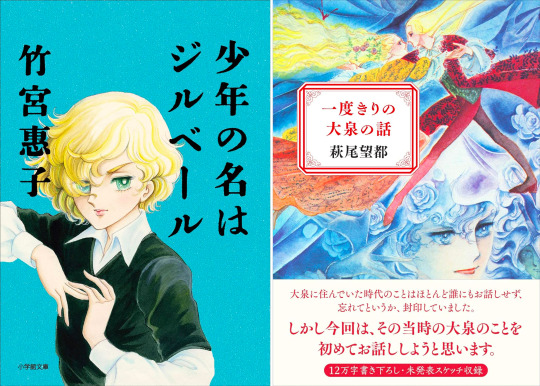
Keiko Takemiya and Moto Hagio, estranged since the late '70s, revealed details of their feud in autobiographic books: Takemiya's "Shonen no na wa Gilbert" (2019) and Hagio's "Ichidou kiri no Oizumi no Hanashi" (2021). The dispute, stemming from Takemiya accusing Hagio of plagiarism, was fueled by Takemiya's jealousy during a challenging creative and personal period. While Takemiya appears self-aware and analytical in her account, Hagio's book indicates she hasn't forgiven Keiko, revealing unresolved feelings. The publications triggered intense online debates.
Masuyama came from a sophisticated family that was very involved in arts and, from a young age, got familiarized with the world of music, literature, and movies. Her refined taste impressed Hagio and Takemiya. At a time when Japanese girls dreamed of Europe, Masuyama actually had friends living there and was up-to-date on the latest European trends. She also had a lot of knowledge of European cinema and literature.
As their rented house was old and rusty, Hagio and Takemiya started spending a lot of time at Masuayama's house across the street. She introduced them to films, songs, books, and paintings. It was Masuyama's taste -- including her interest in movies and books depicting gay romance and her desire for girls' comics to have bolder and riskier themes -- that helped to instill a passion in both artists to go further than the safe cliches usually depicted in shoujo works.
In 1970, editor Yamamoto convinced Takemiya to sign an exclusive contract with Shogakukan. The following year, Hagio also started publishing for Sho-comi and Betsucomi. Their work would attract a loyal fanbase, and aspiring manga-ka would flood their mailboxes. So Takemiya made a decision: to select female artists around her and Hagio's age to mentor and train at their shared home. Thus, the Oizumi Salon was born.
Despite attracting attention, Takemiya and Hagio's works were not always popular. In fact, they'd often rank last in readers' popularity polls, which tend to be all-deciding in manga magazines. But they persevered, and Yamamoto trusted them.

Keiko Takemiya aimed to establish herself with a top-rated series through "Pharaoh no Haka" (left) in order to garner the necessary respect from editors to write the series she wanted, "Kaze to ki no uta" (right). Despite her resolute efforts, "Pharaoh no Haka" never secured the top spot in Sho-comi's readers' poll, peaking at #2. Nevertheless, the series succeeded in elevating her fame and earning her the respect she sought.
In 1972, Hagio had an idea for a serial focused on a male European vampire. However, as she wasn't a famous artist, Yamamoto only allowed her to publish one-shots. So she came up with a plan: to write three interconnected standalone stories. To circumvent another restraint - shoujo editors' avoidance of male leads - she put the first story focus on Marybelle, Edgar's sister. Once Yamamoto realized what Hagio was doing, he was amused and allowed her to continue. And so, "The Poe Clan" series began. In 1974, Shogakukan finally started publishing their shoujo titles in compiled paperback format. In another proof of trust, Yamamoto chose Hagio's "The Poe Clan" as the first title of the Flower Comics imprint.
To everybody's surprise, "The Poe's Clan," in paperback format, was a groundbreaking success, almost instantaneously selling out its initial printing. At the time, Hagio had just started a new serialization, "The Heart of Thomas," a tragic gay love story set in an all-boys German school. As usual for her, the story wasn't all that popular with Sho-Comi's readership, and its lackluster results in the reader's poll almost got the series discontinued. But the notable success of "The Poe's Clan" tankobon assured editors, who allowed Hagio to continue the series. "The Heart of Thomas" went on to become another best-seller and a seminal shoujo title. It also attracted critical acclaim and a loyal fanbase to Moto Hagio, which in turn helped put the Year 24 artists -- who were pretty good at self-promotion -- in the spotlight.
Hagio, Takemiya, and several other "Year 24" authors drifted between being popular and underground. They had a sizable, loyal fanbase that followed them and turned several of their works into best-sellers. On the other hand, by finding a way around the usual shoujo traditions, they weren't particularly popular with the average shoujo reader, ordinary young girls across the country.
Their peculiar position forced them to be clever, so they could fulfill their creative desires as well as their editors' expectations, who were there to make sure the stories published were satisfying to the core readership. Takemiya wrote "Pharaoh no Haka," an Egypt-set romantic adventure, to be well-accepted so that she could then dedicate herself to doing what she truly wanted in "Kaze to Ki no Uta," a gay love story set in a 19th Century French boarding school.
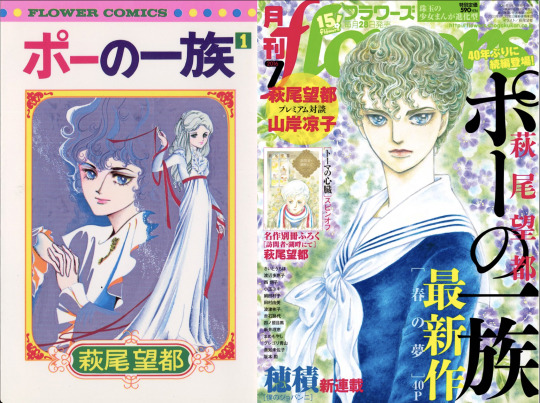
Initially overlooked in popular shoujo magazines, Moto Hagio gained success with "The Poe Clan" in compiled format, launching Shogakukan's Flower Comics imprint. Over time, she became a highly respected manga artist, the only manga-ka alongside legendary filmmaker Hayao Miyazaki to receive a Person of Cultural Merit recognition. In 2016, marking 40 years of the conclusion of her first hit, she released a new "The Poe Clan" chapter in Flower magazine, selling out the increased print run of 50,000 copies in a day. This success marked a significant shift for Hagio, who, despite not being a major magazine seller in earlier years, became a valuable asset to the struggling publishing industry. Following the one-shot, she released three more chapters and, in 2022, began a new sequel series.
Besides Takemiya and Hagio, several other notable shoujo artists who went on to become huge names used to frequent the Oizumi Salon and were part of the "Year 24 group." In the early '70s, most published their work on Shogakukan's titles, which had a "free policy" on storytelling compared to Margaret, Shoujo Friend, Nakayoshi, and Ribon. Then, as Shogakukan started being more strict to properly compete with the market leaders, several moved to newly launched Hakusensha titles Hana to Yume and LaLa. Influential names that were part of the movement included Yumiko Oshima, Yasuko Aoike, and Ryoko Yamagashi, among several others.
Despite their unorthodox preferences, they weren't necessarily trying to rebel against the system, they simply wanted to put out good quality work they believed in. Like other Japanese girls from that era, they were fascinated by Europe, and plenty of their stories took place on the continent. In 1972, Hagio, Takemiya, Yamagishi, and Masuyama made a 45-day trip to Europe, visiting the Soviet Republic, France, and several other countries, which had a profound impact on them. Still, their narratives were widely innovative. They often had male leads, introduced sci-fi, "boys' love," and other bolder genres to shoujo manga, and contributed to the evolution of shoujo illustration. Above all, this group of artists was the one who made clear to naysayers, once and for all, that shoujo manga is indeed an art form.
But while their influence in manga history is undisputed, other significant -- and much more commercial -- manga movements also shook the shoujo manga world during that decade.
A Need for Drama
When talking about '70s shoujo manga, it's common for minds to drift directly to iconic series from that time, like "Candy Candy" and "Rose of Versailles." But, unlike in present times, in that decade, the manga industry's focus wasn't on successful, long-running series but on the artists themselves.
As opposed to the struggling publishing marketing of today, major shoujo manga magazines all sold over 1 million copies during that decade. Manga in tankobon (standalone paperback) format was turning into a money-maker field, but being able to sell paperback was very much secondary compared to being a name capable of selling magazines. Keiko Takemiya and Moto Hagio, from the Amazing Year 24 Group, would go on to become household names and had best-selling series, but, at the time, they couldn't compete with the actual shoujo manga superstars who were the signboard artists of the Kodansha and Shueisha's shoujo titles, the ones who actually moved publications. These artists' work was the most significant indicator of what the mainstream readers wanted and aspired to back then.
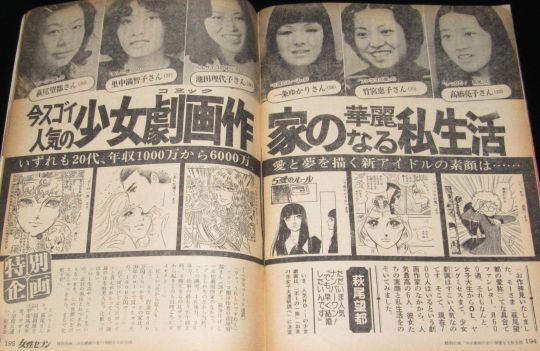
In a December/1975 issue, weekly Josei Seven spotlights the new generation of superstar shoujo manga artists: (l-to-r) Moto Hagio, Machiko Satonaka, Ryoko Ikeda, Yukari Ichijo, Keiko Takemiya, and Ryoko Takahashi. While contemporary manga-kas are highly discreet about their lives and do not even tend to show their faces, in the '70s, they were treated like superstars, and, in the article, the manga-kas openly discuss their love life and details of their high incomes, including how much they had in the bank and how much they spent on rent and daily utilities.
For Kodansha, the top shoujo artist was definitely Machiko Satonaka, who won the Best New Artist competition in 1964, when she was still a freshman in high school. There have been several high-schoolers making their debut in the industry throughout the decades, but, as the first, Satonaka caused a media frenzy. Her ascent gave confidence to countless other young women -- from "Glass Mask"'s Suzue Michi to Keiko Takemiya (who also won a smaller prize in the same competition) -- to pursue their manga careers.
The attention surrounding Satonaka, who went on to become a public personality with TV hosting gigs and other appearances, is another interesting, nostalgic phenomenon. In the past, it was common for manga superstars to have a strong media presence. Nowadays, the norm is the complete opposite: for manga-kas to be highly private, no matter how famous their work is.
In any case, Satonaka quickly proved herself to be more than a sensational news story as she created extremely popular mangas for Kodansha shoujo titles like Shoujo Friend and Nakayoshi. Her style, widely accepted by readers, became symbolical of the story-telling the '70s girls craved: extremely dramatic with emotionally driven plots and lots of bombastic twists and developments.
In his book on subcultures and otaku culture, sociologist Shinji Miyadai notes that '70s shoujo manga can be divided into very few categories. There is the category the Year 24 artists dominated -- which he defines as the "Moto Hagio domain" -- of works with a lot of artistic value, up-to-par with literature. And then there's the far more commercially viable "Satonaka domain," which represented the mainstream taste.
In the "Satonaka category," the artist depicts a stormy life story as a proxy experience for the readers. Of course, there are universal elements of love, friendship, and insecurity that girls can directly relate to. Still, these stories provide adventures that readers could never experience in the real world.
These facets of the "Satonaka domain" are present in almost all the best-selling, mainstream shoujo series of the '70s, like the revolutionary historical romance of "The Rose of Versailles," the dramatic rags-to-riches story of the beautiful orphan in "Candy Candy," and the rise of an ordinary girl to the top of the sports elite in "Ace wo Nerae." In all of these titles, you'll also spot other defining characteristics of '70s shoujo: the death of beloved characters and beloved female characters with voluminous blonde hairs and huge, sparkling eyes (a legacy of Macoto Takahashi, the illustrator who, throughout the '50s, created the art that directly influenced subsequent shoujo history).
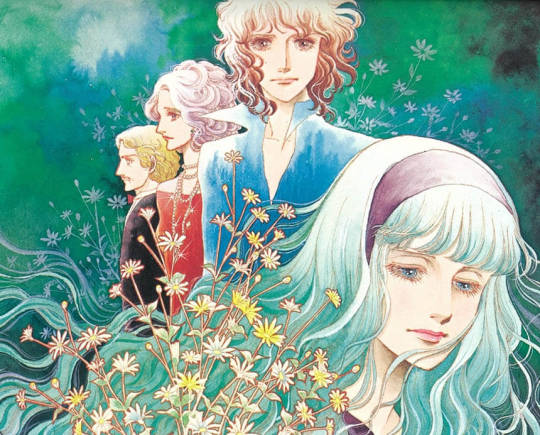
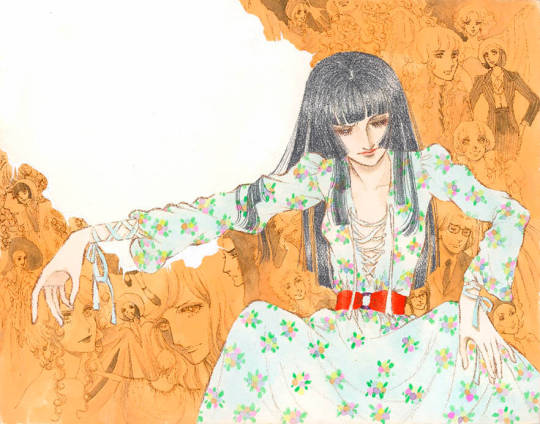
Yukari Ichijo was the most prominent Ribon signboard artist throughout the '70s, creating popular mangas like "Suna no Shiro" (left) and "Designer (right). Young girls across the country adored her work despite the adult drama in it.
Since these stories are extraordinary and dream-like, many of them use Europe or the US as their setting, another reflection of the times when Japanese youth dreamed with the West.
While Satonaka was Kodansha's star, Shueisha also had its top shoujo artists. For Margaret, it was Ryoko Ikeda who kept creating memorable dramatic manga after the conclusion of "The Rose of Versailles." Other classic '70s dramatic works published in the weekly included Kyoko Ariyoshi's ballet drama "Swan." Meanwhile, over at Ribon, no one shone brighter than Yukari Ichijo. Ichijo's works, which young girls across Japan devoured, contained a lot of adult drama with adult characters. Her 1974 manga, "Love Game," had a bed scene. One of her most celebrated works of the decade, "Suna no Shiro" (Sand Castle), dealt with incest. While Ichijo is the one who stood the test of time, another artist who also enjoyed great popularity in Ribon following this formula was Kei Nogami.
These mangas served as an escape for girls, who left their ordinary school life behind for a few hours to embark on extraordinary adventures. In contrast, one of the main genres in contemporary shoujo is unassuming, everyday high school romance. How could the shoujo segment go through such a drastic transformation? The reasons for that also dates back to the 1970s.
Part 3
#shoujo manga#vintage shoujo#otometique#yumiko oshima#keiko takemiya#yumiko tabuchi#hideko tachikake#machiko satonaka#yukari ichijo#ribon#1970s japan#1970s#year 24 group#moto hagio#vintage manga
38 notes
·
View notes
Text

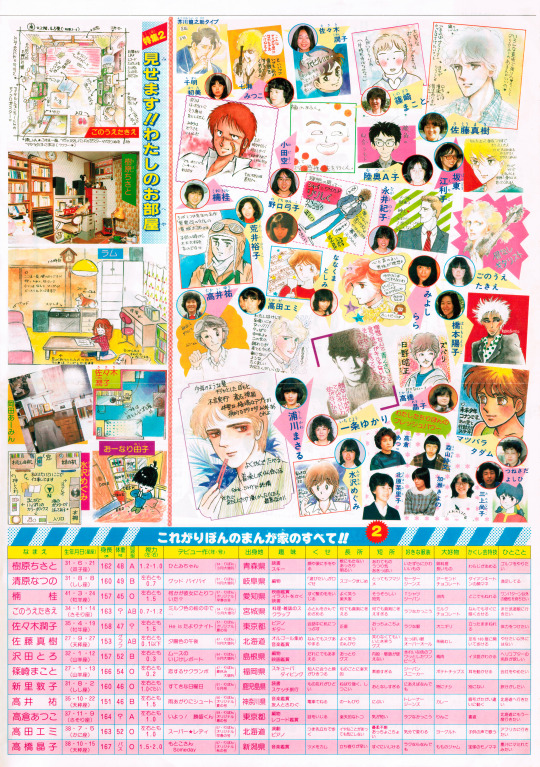

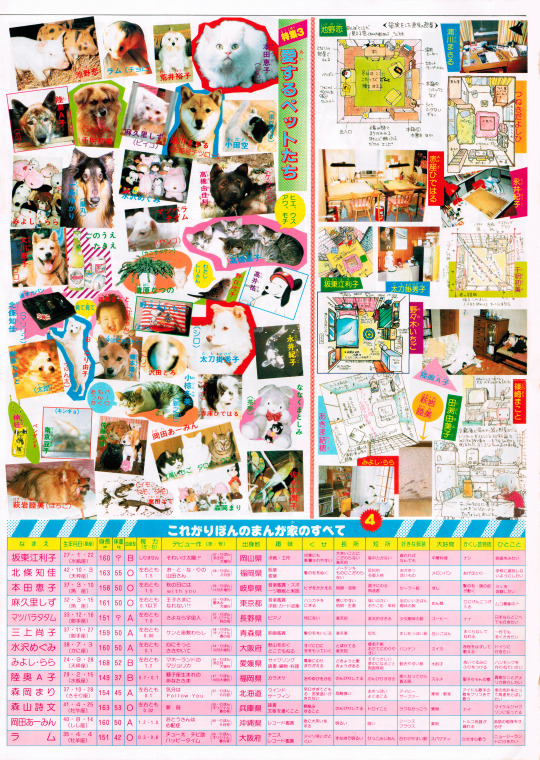
My recent haul included a Ribon "newspaper" furoku from May 1984, and I only intended to scan the Ikeno bits, but turns out this is AH-MAZING so I decided to scan all four pages to share. Basically, a ton of the Ribon artists active at the time answer three questions: "who's your ideal man?" "what does the room you draw manga in look like?" and "what's your pet?" Highlights:

Ikeno draws basically Shun as her ideal man, except I don't think Shun is much of a reader???

I like 80s music so I'm always excited to see manga artists of the time draw or talk about new wave musicians; this is Hagiiwa Mutsumi's fanart of David Sylvian from the band Japan, her ideal man.
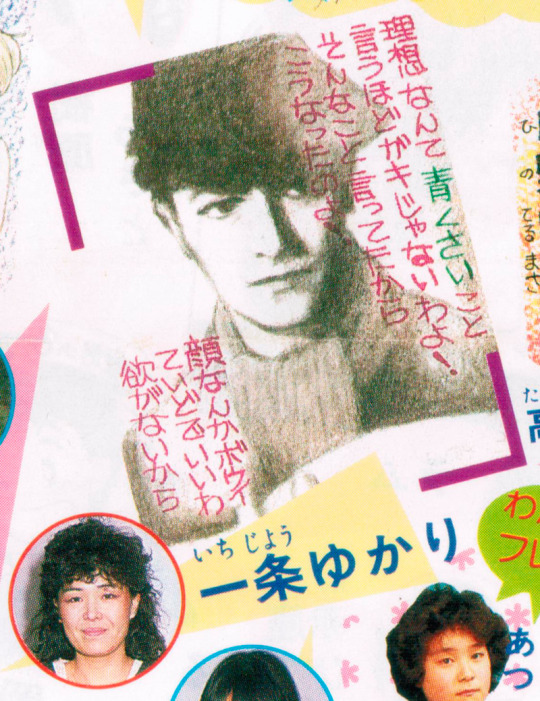
Ichijo Yukari saying she's not greedy and doesn't have high ideals for men's looks, they just have to be "about as handsome as Bowie", which lol.

I'm not sure who this guitarist is supposed to be, all hair metal dudes look the same to me. Michael Schenker, I guess, since Gonoue was apparently a fan?
And some fanart!



Future Boy Conan / Yokoyama Mitsuteru's Babel II / Chiba Tetsuya's Shidenkai no Taka (also a childhood favorite of Takemiya Keiko)
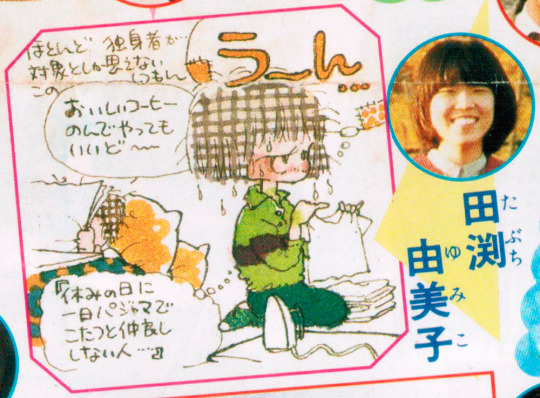
Tabuchi Yumiko, one of my favorite Ribon artists, was already married at this point, so she says her "ideal man" is someone who doesn't stay in their pajamas to lazy around in the kotatsu all Sunday. Tabuchi married a Ribon editor and has written some autobiographical works about her marriage and her children, in which she depicts her husband as... a sea lion.
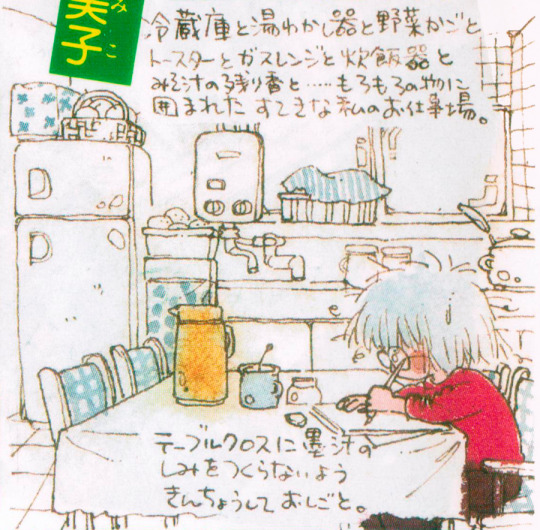
Tabuchi also draws her work space, which is the kitchen. On a side note I just adore Tabuchi's art so much... she has this totally unique yet adorable style and her free hand backgrounds and items make me go ugh, so good.

Ikeno also draws her work space, where we can see Ranze's penguin plushy <3
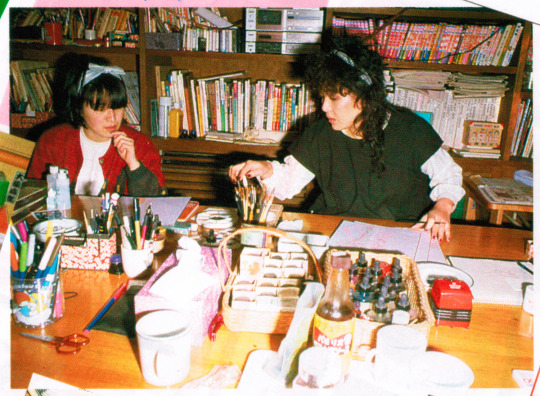
This furoku also features photos of some of the artists' work spaces, and we get an awesome intimate look at Ichijo Yukari's work desk!

More proof of how popular British new wave and rock was among Japanese manga artists in the 80s... there's one more David Sylvian there, and I think I spot Simon Le Bon?
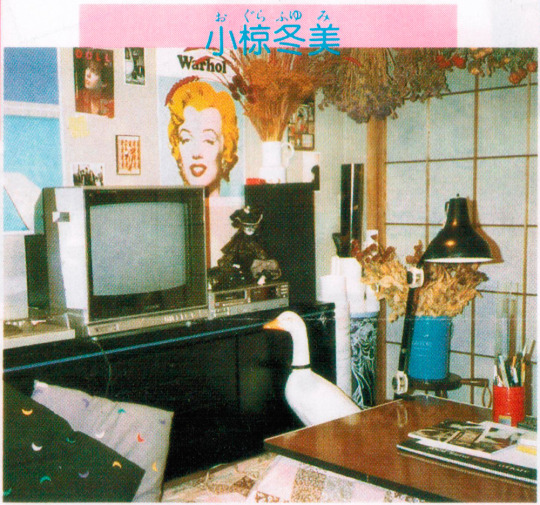
I'm fascinated by this goose in the middle of Ogura Fuyumi's room.
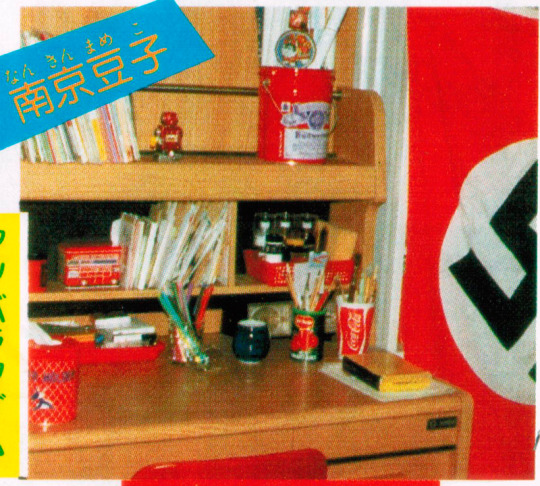
I'm sorry what the fuck is going on here.

And last but not least, please enjoy a photo of Ikeno's adorable "pet" piglets <3 <3 <3 Ikeno was born to a farm and grew up with a ton of pigs, which is one of the reasons she often draws cute piggies!
#ribon#ikeno koi#ichijo yukari#tabuchi yumiko#furoku#long post#very long#sorry#this furoku is listed for 4000-5000 yen which i can see is fair now that i own it and know how amazing it is#but i got it for much cheaper so yay!#i own a bunch of these “info about manga artists” furoku but this is definitely the best one#japanese collectors are always cagey about sharing more than tiny bits of this type of furoku but i don't care everyone must see
95 notes
·
View notes
Photo

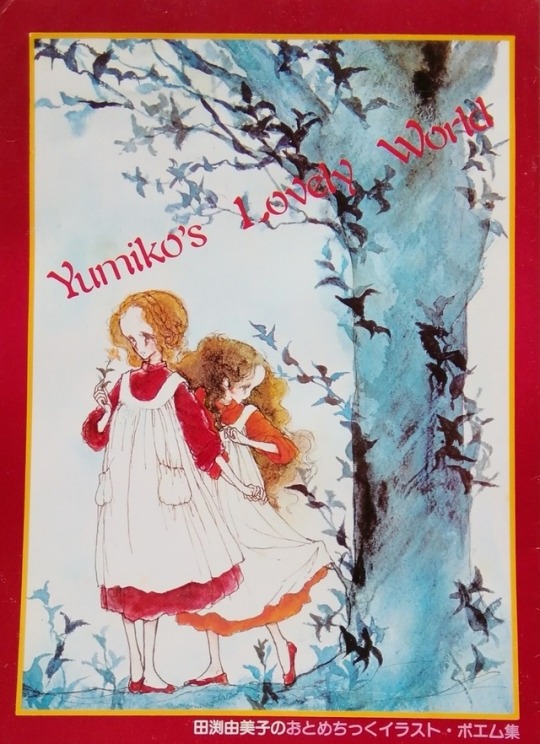
Tabuchi Yumiko
138 notes
·
View notes
Photo
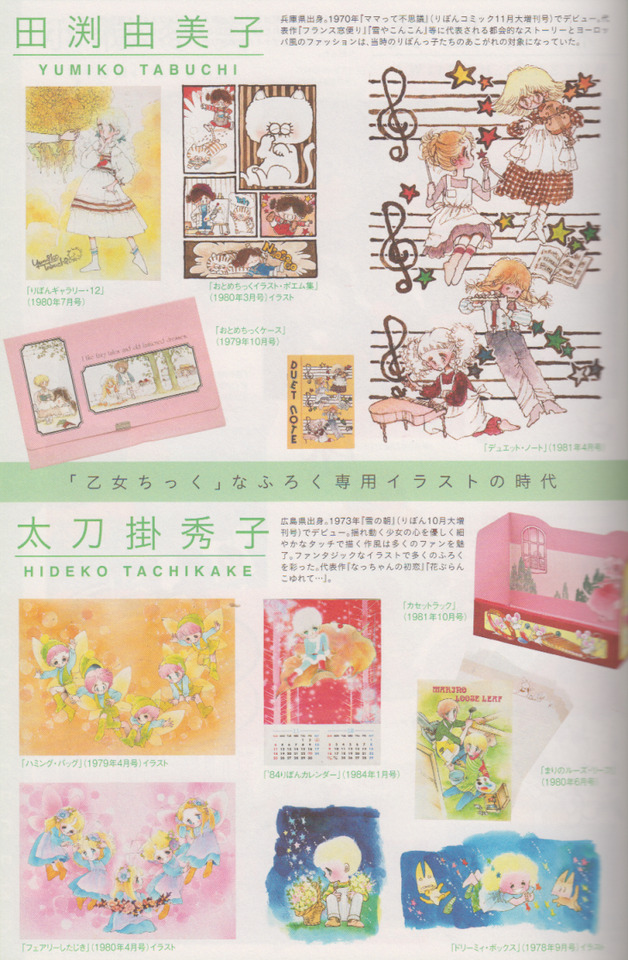
Ribon Furoku: The Secret of Kawaii (x)
16 notes
·
View notes
Photo
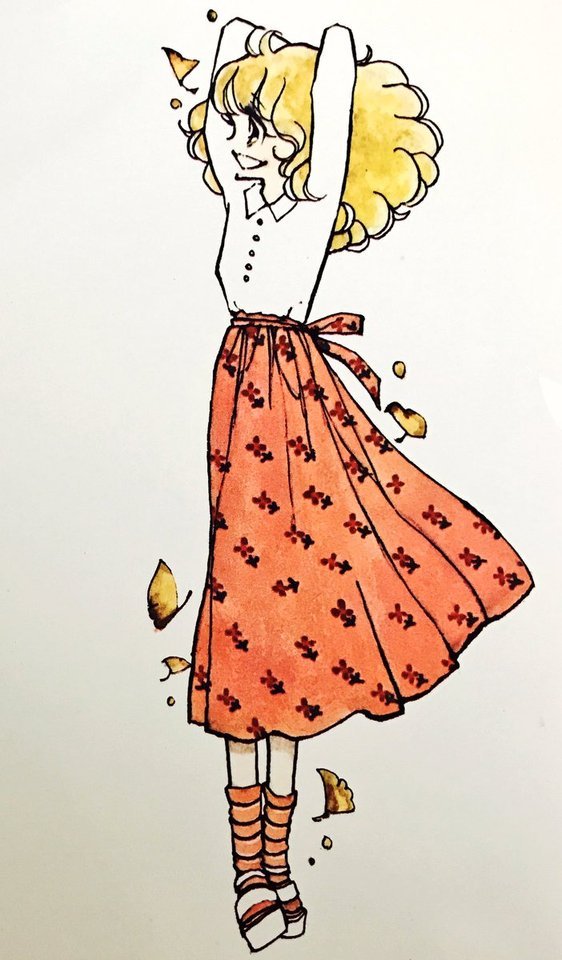
tabuchi yumiko
146 notes
·
View notes
Text

田渕由美子ベストセレクション 憧れのキャンパスライフ編 (Tabuchi Yumiko Best Selection: Akogare no Campus Life-hen), Yumiko Tabuchi
24 notes
·
View notes
Text
Shoujo Manga's Golden Decade (Part 3)
Shoujo manga, comics for girls, played a pivotal role in shaping Japanese girls’ culture, and its dynamic evolution mirrors the prevailing trends and aspirations of the era. For many, this genre peaked in the 1970s. But why?
Part 1
Part 2
Follow the Trend
Before we move on to the third movement of the '70s, let's take a quick look at an essential characteristic of shoujo manga: its sensitivity to trends.
The early '70s were a confusing time for the industry. There was extreme freedom in certain corners, with Yukari Ichijo, Machiko Satonaka, and other prominent artists drawing very adult-like drama in shoujo magazines for young girls. In contrast, there was also a lot of moralism. The fact manga wasn't taken very seriously meant magazines could get away with a lot since adults considered them terrible influences anyway. But, at the same time, since manga wasn't a respected medium, they were also prone to hysteria. Nothing illustrates this scenario better than the controversies surrounding "Harenchi Gakuen," the first full-length series by Go Nagai, who went on to become one of the most celebrated manga names in the '70s.


Shameless! The nudity and erotic jokes in Go Nagai''s "Harenchi Gakuen" were a hit with kids and teens, scandalized parents and teachers, and made the shoujo industry chase after their own erotic hits.
Nagai, already a respected yet fledgling name in the industry, was recruited by Shueisha to be part of Shonen Jump's inaugural team in the late '60s. Jump, as any manga fan knows, is by far the biggest success story in manga editorial history. However, back then, it was just a newcomer in a field dominated by Kodansha's Weekly Shonen Magazine and Shogakukan's Shonen Sunday. Go Nagai's series, whose translated name meant "Shameless High School," is Jump's first big hit and one of the titles that propelled the magazine to sell over 1 million copies.
But "Harenchi Gakuen," a gag manga with erotic jokes, scandalized adults across the nation. The Japanese Parents and Teachers Association successfully led a Shonen Jump boycott, getting the magazine banned in several shops across the country and triggering a media circus. At the time, agitated journalists often accosted Go Nagai at airports and public events, aggressively pointing their mics at him, a consequence of manga-kas celebrity-like notoriety during that era.
Meanwhile, the reaction around "Harenchi Gakuen" did not intimidate other manga magazines. In fact, all of them were pursuing their own "harenchi"-like phenomenon and publishing stories with erotic dirty jokes. And yes, that included the manga magazines for little girls. In Ribon, male manga-ka Hikaru Yuzuki was responsible for the "dirty" manga series. At Weekly Margaret, Yuzuki also had a considerable hit with the high school comedy "Elite Kyousoukyoku," which, while not precisely "ecchi," had a tone reminiscent of Nagai's work. At Nakayoshi, the artist in charge of this type of content was none other than a pre-"Candy Candy" Yumiko Igarashi.

Before finding success with the smash hit "Candy Candy" manga, Yumiko Igarashi was the Nakayoshi artist in charge of recreating the "harenchi" phenomenon in the pages of the magazine. Above, in a good display of how public manga artists were in the '70s, Yumiko describes her panties as part of a Nakayoshi feature.
The "harenchi" phenomenon hinted at a shoujo field that wasn't yet wholly solidified and, therefore, was taking cues straight from the shonen segment, which would later become uncommon. But it is also an example of how the genre projects readers' dreams and preferences.
An example of this is one of Ribon's most popular series during the '70s, Yukko Yamamoto's "Miki to Apple Pie," a gag high school manga full of absurd humor and nudity in the "Harenchi" vein. The twist is that it also had everything girls dreamed of.
The "apple pie" in the title was a reference to the lead character's favorite dessert during the time the American apple pie had just arrived in Japan and was considered the trendiest sweet. Miki Miyazawa, a popular and beautiful girl who served as the proxy for readers and was loosely modeled after talento Aki Aizawa, also loved astrology and the horoscope, and the romantic lead was a transfer student named Hideki Nanjo, who was a carbon copy of Hideki Saijo, the biggest popstar heartthrob of the '70s. Basically, "Miki to Apple Pie"'s central premise was "What if the popstars girls go crazy for was your silly gorgeous classmate?".
In fact, a testament to Saijo's popularity was how many shoujo manga romantic partners of the era used him as a model. Besides "Miki to Apple Pie," inserts of him were present in Satonaka Machiko's "Spotlight," Shigeko Maehara's "Kimi Iro no Hibi," Mayumi Yoshida's "Lemon Hakusho," among others.


With nudity, slapstick humor, and a lot of reference to trends and pop culture, "Miki to Apple Pie" was a massive hit on the pages of '70s Ribon. The romantic lead, Hideki Nanjo, inspired by heartthrob Hideki Saiji, would often do impromptu performances of the pop hits of the times from famous stars like Agnes Chan, Finger Five and, of course, Hideki Saiji himself.
Saijo is a relic of the past, but shoujo echoing the trends of its time is a timeless characteristic of the genre. That's why most shoujo artists are women who are close in age to their readers: this sensibility to girls' desires is a vital component of the market. From the way the characters look to how they dress to even the shape of their eyebrows, everything is supposed to reflect its time. Therefore, to successfully create shoujo, one has to understand how girls perceive themselves and also how they want to be perceived. How they dress and look, but also how and what they dream of looking and wearing. What they aspire to and, above all, what they find attractive in the opposite sex.
It was precisely that sensitivity and this unique sense of what girls want and dream of that led to the creation of what is now the number 1 shoujo manga trope: the high school romance starring an unassuming, ordinary heroine. Leading the way was another group of artists that, while not as internationally celebrated as the Year 24 Group, are definitely equally as crucial to shoujo history.
The Otometique Fervor

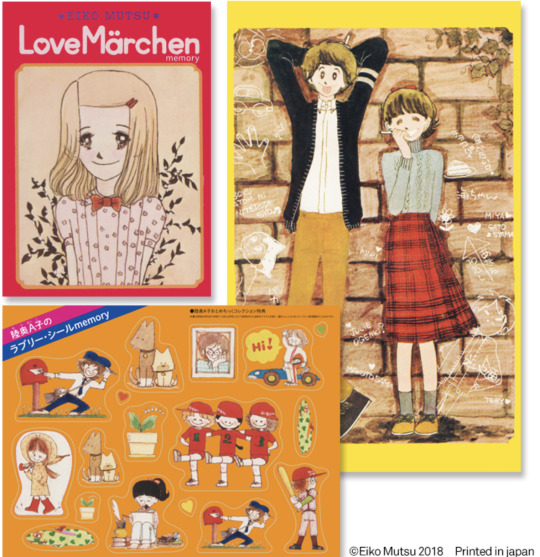
An "otometique" girl by Mutsu A-ko and some of the artist's popular furoku.
Yoshiko Nishitani, another of Shueisha's top shoujo artists of that era, is often credited as being the first to create a series around ordinary high school love. She did that in 1965's "Marie Lou," published in Weekly Margaret. "Marie Lou" was set in an American high school and had a very fashionable white girl as its lead. On her next manga, "Lemon to Sakuranbo" (Lemon and Cherries), she'd once again achieve immense success by bringing the teen romance closer to reality, using an ordinary Japanese high school as a backdrop.
While Nishitani pioneered this narrative style, the rise of more realistic, everyday stories gained momentum about a decade later. One catalyst for this was the "Otometique boom," a phenomenon that unfolded in the pages of Shueisha's Ribon magazine in the latter half of the '70s.
The term "Otometique" combines "otome," meaning "maiden" or a pure young girl, with the "-tique" (tikku in Japanese) suffix. A-ko Mutsu was the artist who spearheaded this movement.
A-ko made her debut in Ribon in 1971 at the age of 18. Her popularity skyrocketed four years later when her first short stories, led by "Tasogaredoki ni mitsuketa no" (What I Found at Twilight), were compiled into a tankobon that became a best-seller. This success elevated her status in Ribon, and soon her "otometique" style became the talk of the town.

Mutsu A-ko's art.
In contrast to the dramatic narratives of the "Satonaka-domain" faction, "otometique" stories adopted a more straightforward structure devoid of major plot twists and intense drama. Instead, they focused on modest love stories where the exhilarating moments were ordinary occurrences, like spotting a cute boy on the street or touching a crush's hand for the first time. While some stories included sad or supernatural elements, readers were captivated by the uncomplicated, heartwarming moments.
Ako's heroines were ordinary, unassuming schoolgirls, often characterized by shyness and insecurity. Different from extraordinary characters like Lady Oscar from "BeruBara" or the iconic Madame Butterfly tennis star in "Ace wo Nerae," Ako's protagonists were life-sized.
"Otometique" manga often incorporated romantic comedy tropes, such as chance encounters with cute guys on the way to school or the transformation into beauty after removing glasses. The happy endings typically featured a boy reciprocating the girl's love by accepting her as perfect and beautiful just as she was.

In otometique manga, girls were often in cute plaid and gingham check dresses and skirts, while boys were impeccably dressed in Ivy style, as seen in Mutsu Ako's art above.
While the stories may have seemed mundane, their distinctiveness lay in the meticulous attention to detail. As significant as the exploration of falling in love and discovering inner strength were all the visual details in "otometique" art. Girls had braids or long wavy hair and wore adorable clothes with plaids and gingham-check, as well as cute accessories. At a time when most Japanese girls still had Japanese-style rooms, "otometique" heroines had gorgeous Western-style rooms. They hung out in cozy cafes, made handmade goods, and ate tasty-looking sweets. Houses had French windows and balconies. Boys were tall, lean, with fluffy hair, and were always dressed impeccably in Ivy-style clothes. The "otometique" artists created an atmosphere that perfectly matched girls' aspirations at the time.
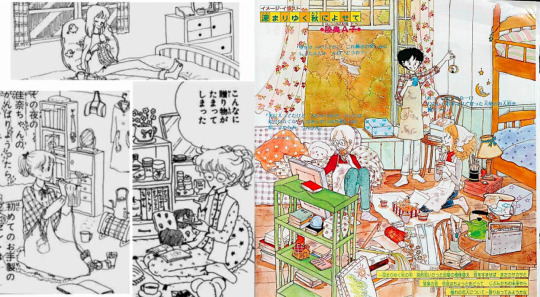
Girls often dreamed with having Western-style bedrooms like the ones in Otometique manga.
While Mutsu A-ko was the trailblazer, she was soon joined at the top by two other iconic artists, Yumiko Tabuchi, and Hideko Tachikake. Each of them had their quirks. Tabuchi, for example, often had college girls as her heroines, mirroring herself as a student at the elite, trendy Waseda University. While Tabuchi and A-ko preferred short stories, Tachikake had a penchant for longer series with a bit more drama. But they all had a similar aesthetic and relied on ordinary stories about love.
The "otometique" phenomenon reflected the trends of the time and foreshadowed the emerging consumer culture that would swallow the country in the next decade. The sophisticated visuals attracted people of all ages, from elementary school-aged girls to highly educated women and men. Both the top public and private universities in Japan, Tokyo University and Waseda, respectively, had famous "otometique" clubs full of students who loved the genre and the style. The mangas were so trendy they were often referred to as "Ivy mangas," in reference to the iconic Ivy style that was the catalyst of Japan's youth fashion which was going through a second revival around that time.
While projecting an atmosphere that girls dreamed of, "otometique" also showcases '70s youth and girls' culture. Melancholic, simple love stories among young people were also the theme of the big folk hits of the time. Ivy or country fashion and long hair for men were the trends. Western-inspired ideals- in decoration, fashion, and musical taste- were pervasive. And creating subcultures and hobbies around consumption was the path society was taking. Simple life-sized stories as a narrative preference echoed the reality of Japan, which was stabilizing itself after decades of turbulence. These stories brought what the country was craving: comfort.


Above, a Mutsu A-ko's bedroom that lived in girls' imagination. Below, the room is recreated in a 2021 exhibition of Ako's art.
Meanwhile, the rise of consumer culture among young girls led to a "fancy goods" boom, with stores selling cute stationery, stickers, and small items popping up everywhere around the country. Illustrators and companies, eager to capitalize, spared no time in creating appealing mascots and drawings to adorn these goods, and it was in that period that Sanrio created Hello Kitty.
Ribon and Nakayoshi, which were "furoku" magazines, also benefitted. Furoku are extra gifts that come with the purchase of the magazines. And the "otometique" boom meant Ribon could include "fancy goods" -- like notebooks, stickers, letter sets, and small paper goods readers could assemble -- with the illustration of these highly sought-after artists. Most girls around Japan could only dream of Western-style rooms, a closet full of cute Ivy fashion, trips to trendy cafes, and homes with French windows. But they could recreate a bit of this sophisticated atmosphere by having letter sets, notebooks, stickers, and small accessories with A-ko Mutsu, Hideko Tachikake, and Yumiko Tabuchi's art. These popular furokus and the "otometique" stories were critical for Ribon magazine to surpass 1 million copies in circulation.
Girls admired A-ko, Tabuchi, and Tachikake not only as artists creating heartfelt stories with attractive atmospheres but as personalities. The trio, who were in their late teens and early 20s, closely resonated with their fans due to their proximity in age and shared interests. The readers were moved when Ribon featured an article in which A-ko Mutsu had the opportunity to meet and interview her favorite singer, the rock star Kenji Sawada, a prominent teen idol of that era. The positive response was so overwhelming that, a few issues later, Hideko Tachikake, an avid folk music enthusiast, also had the chance to interview her idol, Kosetsu Minami, the lead singer of Kaguyahime.
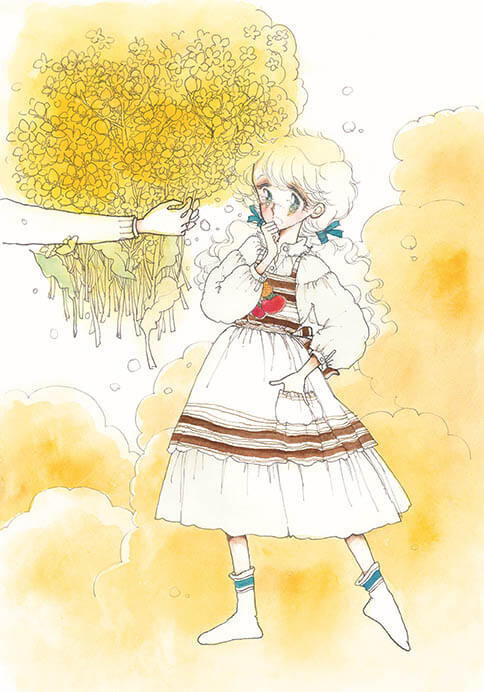
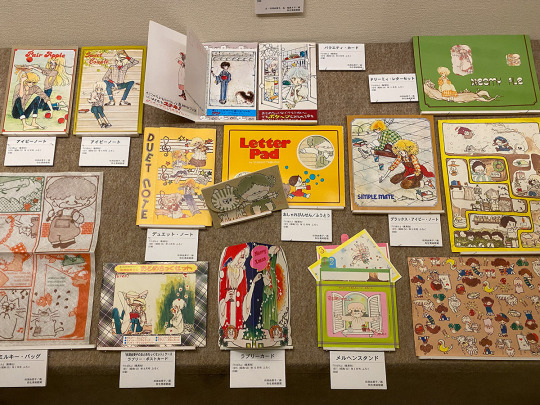
An otometique girl by Yumiko Tabuchi (left) and a collection of furoku illustrated by her as seen on a 2021 exhibition on her art.
The popularity of "otometique" peaked in 1977. By 1981, the boom had almost faded, and Ako, Tabuchi, and Tachikake published their last work on Ribon in 1985. Tabuchi and Tachikake married and semi-retired, while Ako successfully transitioned to manga for adult women.
Despite the end of the style, "otometique" permeated every corner of Japanese society. Its furoku and atmosphere were one of the bases for the almighty "kawaii" culture which now rules the country. The life-sized heroines and focus on mundane love stories and everyday emotions went on to become one of the main characteristics of the shoujo manga industry.
The Iwadate Domain
For years, the influence of "otometique" has been downplayed, one of the reasons why the movement is almost undiscussed in the West. However, in the last few years, best-selling books reminiscing the style were published, and exhibitions of A-ko Mutsu and Yumiko Tabuchi's works were big hits across Japan. Ako, who moved back from Tokyo to her hometown in Fukuoka and never stopped working on manga, was recognized by the local prefecture as an honorary citizen and gained a permanent museum in the area, signaling her importance to the industry.
But while the "otometique" phenomenon happened on the pages of Ribon magazine, Mutsu, Tabuchi, and Tachikake weren't the only three attracting a massive audience to this type of real-life love story.

Mariko Iwadate's work was extremely popular from the late '70s to the mid-2000s. Above, a collection of her work from her Margaret era.
Going back to the research of sociologist Shinji Miyadai, three domains divided '70s shoujo. There was the "Moto Hagio domain," which included the Year 24 artists. The Hagio domain was more highbrow and intellectually challenging, and many considered it an equivalent to literature, attracting the intellectual elite that sniffed at manga in general. It is by far the most discussed and debated '70s shoujo movement, as well as the most famous in the West, but it was the least commercially successful at the time. Then there was the "Machiko Satonaka domain," with emotionally driven stories full of drama, plot twists, and larger-than-life heroines. Most of the '70s best-selling shoujo series fall under this category, which includes the work of Yukari Ichijo and Ryoko Ikeda and sports manga like "Ace wo Nerae," among others.
Finally, there's the domain in which the "otometique" stories were created. And Miyadai doesn't name it after any of the Ribon artists, calling it the "Mariko Iwadate domain" instead.
In the Satonaka domain, the heroine served as a proxy for the reader in a fantastical world, while in the Iwadate domain, the heroine represented the reader in the real world. But who is the influential Iwadate?
Mariko Iwadate, who made her debut in 1973 at the age of 16, rose to prominence by embracing the "otometique" style during its peak in the late '70s. Similar to Ribon artists, Iwadate captivated readers with her elegant and stylish art, featuring cute clothes, accessories, and intricate details.
Miyadai's choice to name the category after Iwadate rather than the genre pioneer Ako Mutsu may be attributed to Iwadate's sustained success. After leaving Ribon in 1985, Ako remained prolific but couldn't replicate her peak, while Iwadate continued her success even after she transitioned to adult women's manga. Iwadate's work, recognized for its emotional depth, became a significant inspiration for trailblazers like best-selling novelist Banana Yoshimoto and avant-garde manga artist Kyoko Okazaki. In 1993, when Miyadai wrote his book, Iwadate's fame and respect probably made her a more recognizable figure for readers to associate with the category.

Iwadate's soft girly art and story-telling made her extremely popular and influential.
Mariko Iwadate's narrative, especially her post-80s work, has a more psychological and mature element to it when compared to Ribon's artists. She, as an artist, bridged the gap between "otometique" and another highly influential "Iwadate domain" artist, Fusako Kuramochi.
Fusako Kuramochi, debuting while still a teen in the early '70s at Bessatsu Margaret, initially emulated her favorite artists, Moto Hagio and Keiko Takemiya, before finding her style—a realistic portrayal of romance with a substantial psychological element. Her success contributed to shaping Betsuma, alongside Ribon, as arguably the most influential and commercially thriving shoujo title -- the go-to magazine for high school romcom.
Like the otometique artists, Fusako Kuramochi first gained prominence with short stories and one-shots. In 1979, she wrote her first series, "Oshiaberi Kaidan," in which each chapter depicted the life of a young girl from junior high to her graduation day. In 1980, she published "Itsumo poketto ni Chopin," a classical music manga that was also about growth. From then on, she'd publish about two hit series every year in Betsuma before graduating successfully to adult women's manga in 1994.
Kuramochi's success was due to her great skill in portraying girls going through crushes, heartbreaks, and jealousy. The psychological elements struck a chord with readers and helped her create male romantic leads that were extremely popular.
Another component of Kuramochi's work was her sophistication, a result of her upbringing. Her father was the chairman of one of Japan's biggest printing companies, and she was raised in Shibuya, in the center of Tokyo, while attending an exclusive all-female institution. The fact she spent her youth in the middle of Tokyo's hustle and bustle meant she knew the capital well, and her works were full of references to trendy cafes, restaurants, nightspots, and neighborhoods. Her Betsuma work was published right before, and during Japan's luxurious Bubble years, so many chasing an exciting city life referred to her mangas.
While her Betsuma work reflected the reality and aspirations of the Bubble years, Kuramochi's true gift lay in providing readers with a realistic depiction of growing up and falling in love, making her stories immensely popular. In general, consumerism -- displayed through clothes, accessories, and decor -- isn't as crucial to her success as the three Ribon "otometique" artists.
While Fusako Kuramochi is part of the "Iwadate domain," you can argue that Kuramochi evolved into her own category, which was vital for the development of real-life love stories in shoujo in the '80s and '90s and the rise of other highly-influential artists like Ryo Ikuemi.
But going back to the three '70s movements, "otometique"/"Iwadate domain" was definitely the most influential one in steering shoujo manga in its current direction. On the other hand, all of these domains co-existed together and fed from each other. In 1977, during the "otometique" boom, Yukari Ichijo remained untouched as one of Ribon's most popular artists with her emotionally charged dramas. It was the success of Ichijo and other "Satonaka domain" artists that allowed the "Hagio domain" to debut and take risks. In turn, it was the "Hagio domain" that showed there were rewards for young risk-taking shoujo artists.
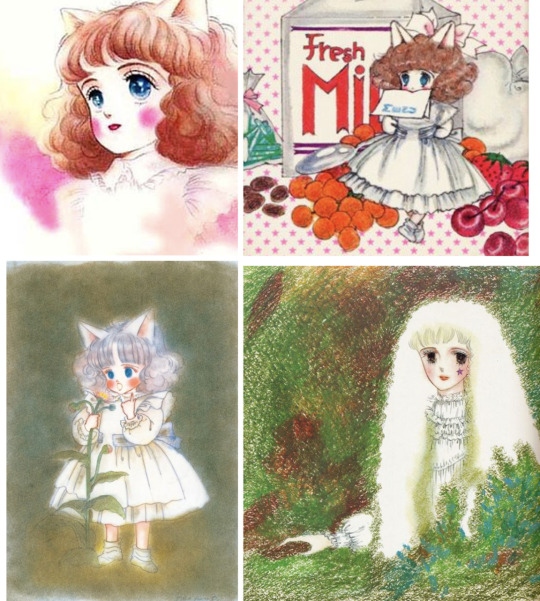
Yumiko Oshima, known for her girly art and sensitive story-telling, is the inspiration behind the otometique boom.
When asked which artist inspired them the most, both Ako Mutsu and Mariko Iwadate gave the same answer: Yumiko Oshima. Oshima, known for her quirky love stories and girly art, is an artist who trained alongside Hagio and Takemiya at the Oizumi salon and rose as part of the "Year 24 group," publishing risk-taking manga in Shogakukan and Hakusensha's magazine after a brief stint in Weekly Margaret. In other words, despite the striking differences, the origin of the "Iwadate domain" is the "Hagio domain."
While the influence of the idealized real-life romance is the one we can better observe today, contemporary shoujo would not exist if not for all these three styles meshing together and creating something new. And from that, things kept evolving and changing and gaining new forms. Because, once again, manga, and especially shoujo manga, is about reflecting the ideals of its time.
#ribon#margaret#go nagai#miki to apple pie#yumiko tabuchi#otometique#otometique manga#mutsu a-ko#mutsu ako#hideko tabuchi#70s japan#fusako kuramochi#betsuma#shoujo manga#vintage shoujo#vintage manga#harenchi gakuen#yumiko igarashi#nakayoshi#yumiko oshima
21 notes
·
View notes
Text

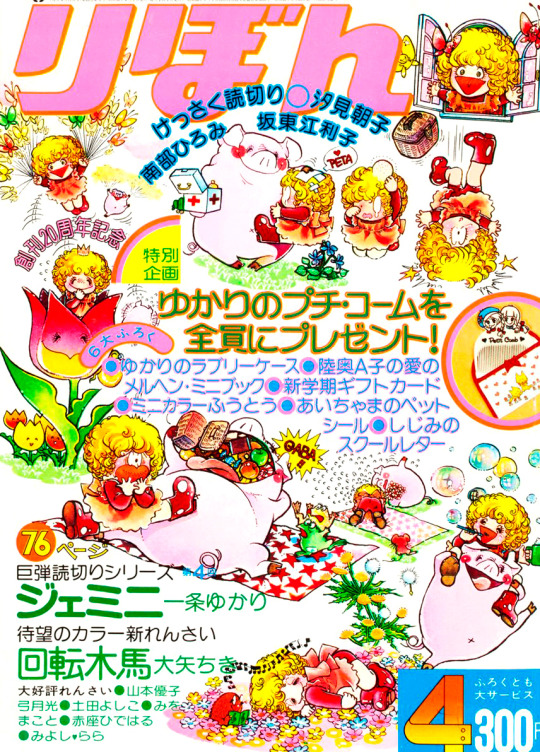
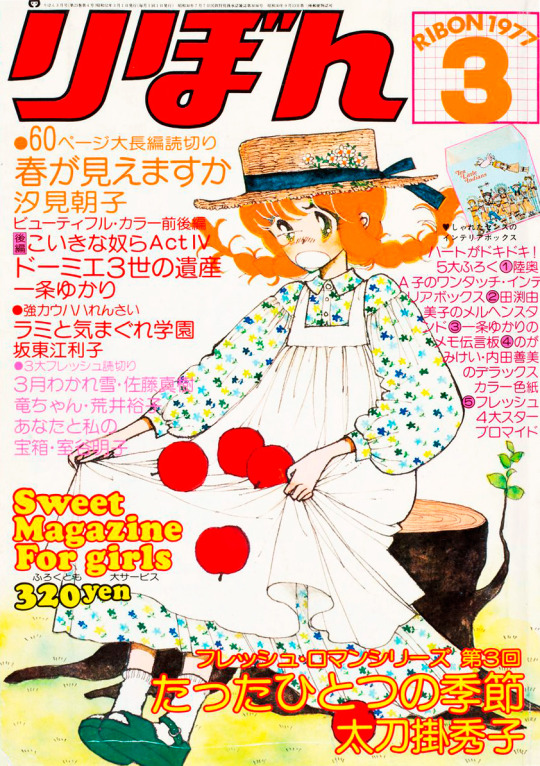
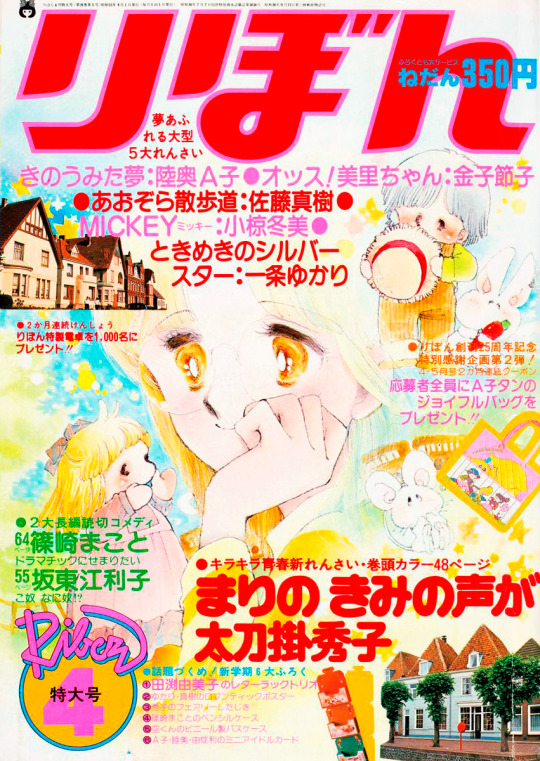



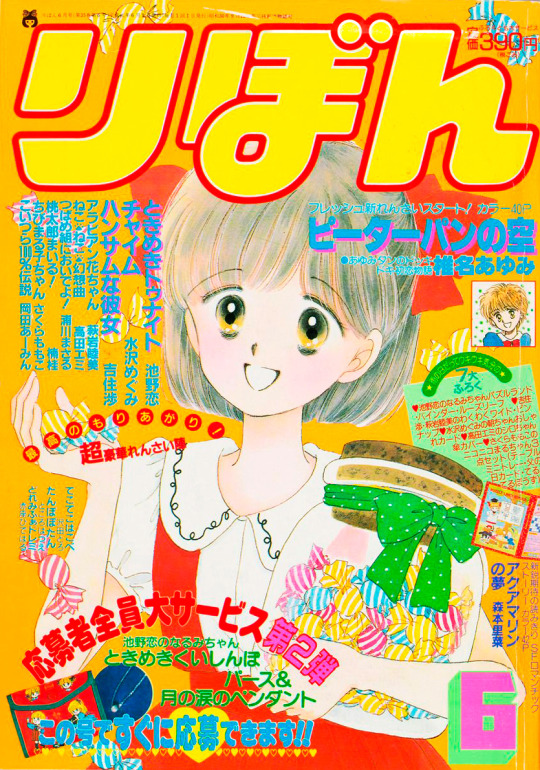

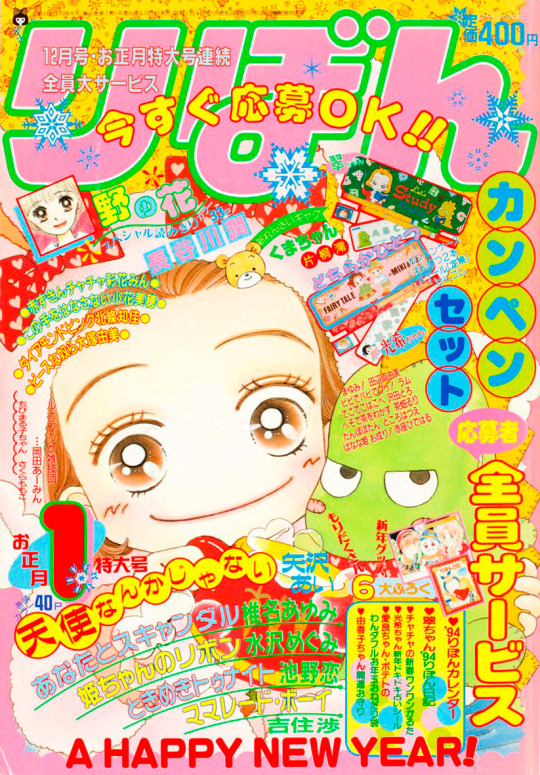
My top 10 favorite Ribon covers from the 70s + 80s + 90s
#ribon#yamagishi ryoko#oya chiki#tabuchi yumiko#tachikake hideko#hagiiwa mutsumi#hiiragi aoi#takada emi#mizusawa megumi#yoshizumi wataru#yazawa ai#a lot of major ribon artists are missing here but this is based on my personal tastes so
111 notes
·
View notes
Photo
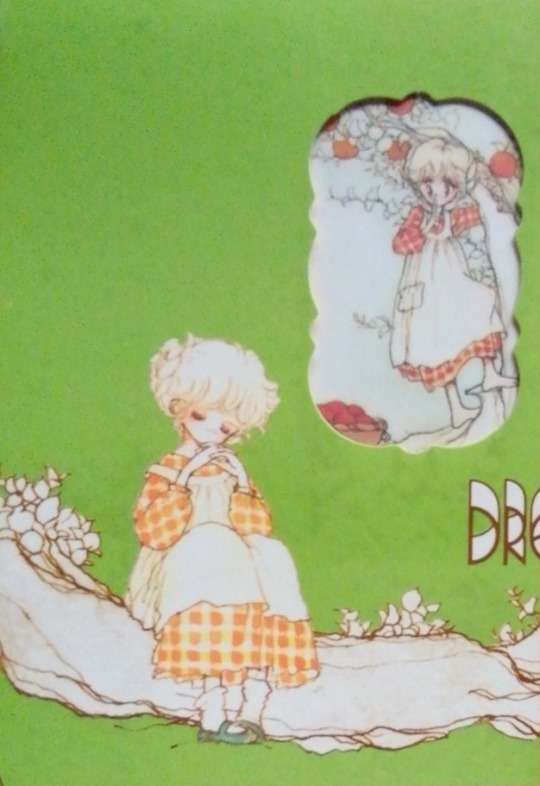

Tabuchi Yumiko
73 notes
·
View notes
Photo

tabuchi yumiko
125 notes
·
View notes
Text
Yumiko Tabuchi Exhibition
Yumiko Tabuchi Exhibition
at Yayoi Museum
Media: Manga
(2021-02-11 - 2021-06-06)
An exhibition for the illustrator Yumiko Tabuchi, whose work debuted 50 years ago and was featured prominently from the 1970s in the shojo manga magazine “Ribbon.” *Online reservations required.
from TAB Events - Most Popular https://www.tokyoartbeat.com/event/2021/5DE6
Yumiko Tabuchi Exhibition
at Yayoi Museum
Media: Manga
(2021-02-11 - 2021-06-06)
An exhibition for the illustrator Yumiko Tabuchi, whose work debuted 50 years ago and was featured prominently from the 1970s in the shojo manga magazine “Ribbon.” *Online reservations required.
https://www.tokyoartbeat.com//media/event/2021/5DE6-80
via Art Japan
0 notes
